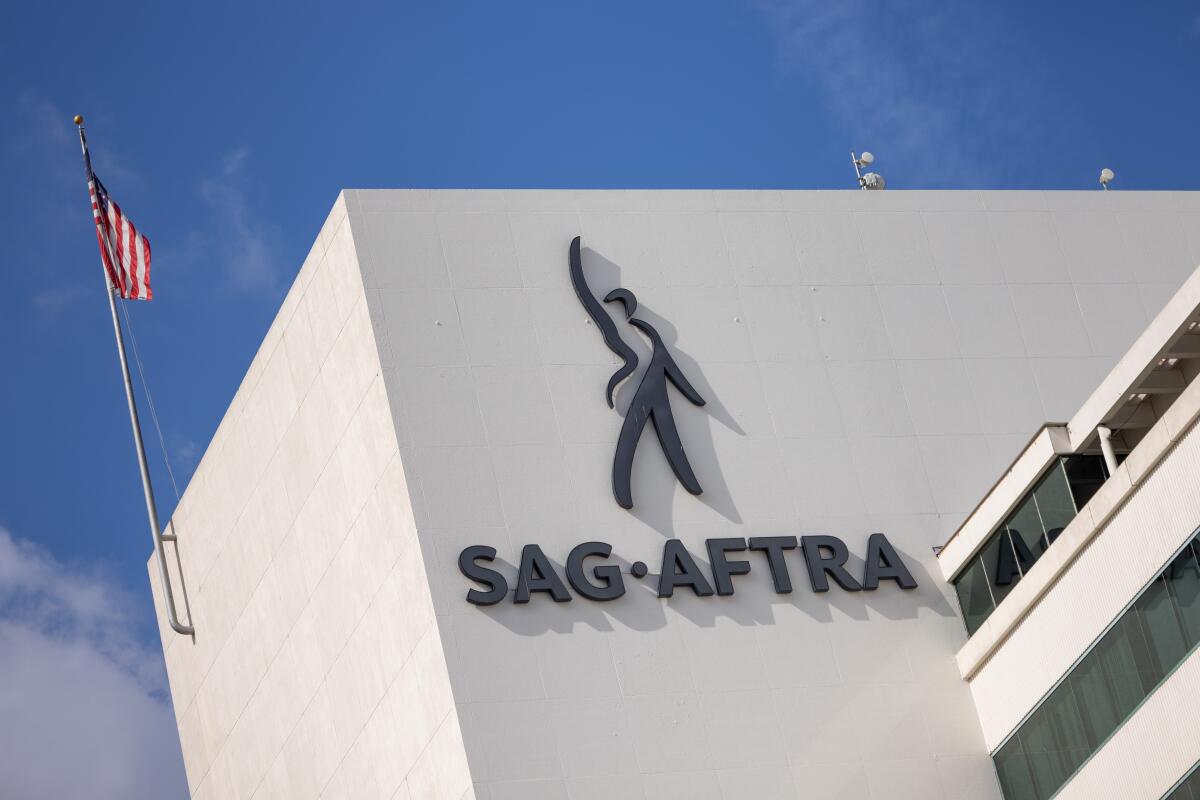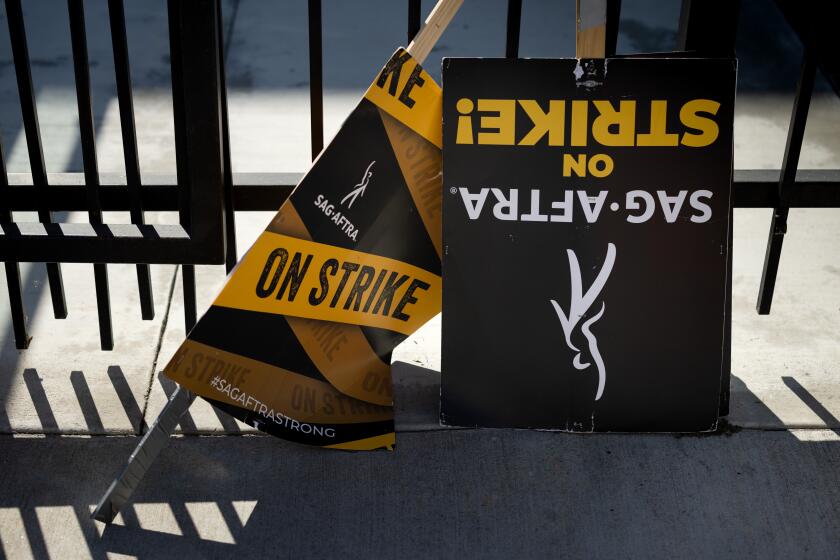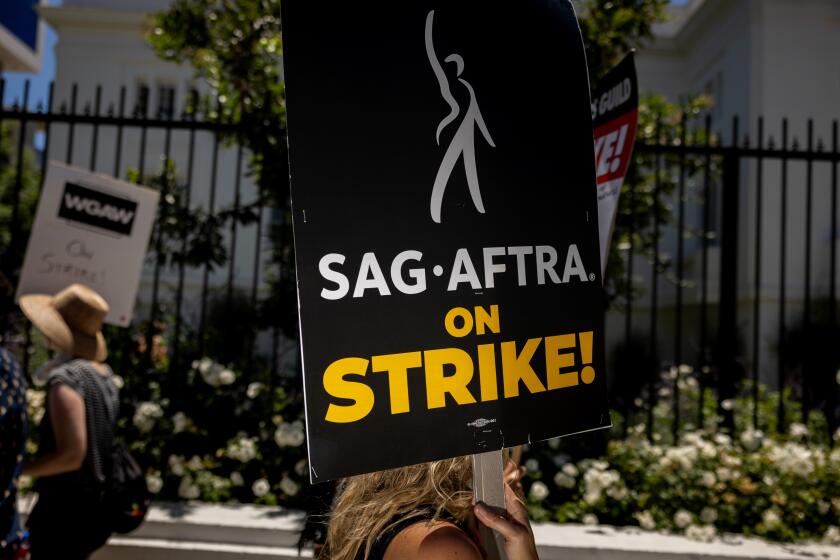What’s in the SAG-AFTRA deal? Here’s what the union has to say, including about AI terms

- Share via
SAG-AFTRA has released a summary of its tentative agreement with the major Hollywood studios, which ended the actors’ strike last week.
The Screen Actors Guild-American Federation of Television and Radio Artists published the 18-page document on Sunday night. The summary covers deal points related to residuals, casting and auditions, pension and health benefits, performance capture, wages, equity and inclusion, sexual harassment prevention and the use of artificial intelligence.
Last Wednesday, the performers union and the Alliance of Motion Picture and Television Producers reached a tentative agreement to end the 118-day actors’ strike. The walkout has been suspended until the new contract is ratified by the guild’s 160,000-person membership.
The SAG-AFTRA board has approved a landmark deal to end the union’s strike. The vote clears the way for guild members to approve or reject the contract.
Rank-and-file members of SAG-AFTRA will have the opportunity to vote on the contract starting Tuesday after 86% of the guild’s national board of directors approved the tentative deal.
“There are things that we wanted to get in this negotiation that we weren’t able to achieve,” SAG-AFTRA National Director and Chief Negotiator Duncan Crabtree-Ireland said at a news conference held Friday, noting that a few board members were dissatisfied. “But that’s what negotiation is about. It’s a give-and-take process — not a process where one side comes in and just gets everything that’s on their list.”
SAG-AFTRA has approved a deal from the studios to end its historic strike. The actors were on strike for more than 100 days.
Some actors, including Justine Bateman, have criticized the protections outlined in the tentative agreement and argued that they don’t go far enough — especially when it comes to AI.
Here’s a summary of the summary (which can be viewed here in its entirety):
Wage increases
Wage minimums for performers will increase by 7%, effective immediately, followed by another 4% increase in July 2024 and a 3.5% bump in July 2025.
Minimums for background actors, stand-ins and photo doubles also will increase, rising 11%, effective immediately, followed by another 4% increase in Year Two of the contract and a 3.5% increase in Year Three.
Artificial intelligence
In cases where a performer’s employer seeks to create a “digital replica” of the actor’s voice or likeness with the intent of using the copy in their place, the employer must first obtain “clear and conspicuous” consent from the performer.
The employer also must get the performer’s permission to use the replica, “unless the photography or sound track remains substantially as scripted, performed and/or recorded.”
The employer must pay the performer for the amount of days they would have been required to perform scenes featuring their digital likeness. No additional pay is required if the replica later replaces the actor in scenes they were already paid for performing in person.
If a digital replica of a background actor is used to portray a principal character, the background actor must be compensated for the days they would have worked in person (plus residuals).
Schedule F performers (actors who meet a higher-salary threshold) would not receive additional pay for use of their replicas.
“Our primary focus in setting those minimums was to address performers who are working at scale — who are working at day-player minimum or weekly performer minimum — to make sure that they at least got compensated fairly for that [replica] use,” Crabtree-Ireland said. “Schedule F performers are accustomed to negotiating over other items. The most important thing was protecting their rights of informed consent.”
Additionally, the performer is owed residuals for their digital replica’s screen time.
If the employer wishes to use a performer’s digital replica for a project beyond the production the actor was employed for, the employer must obtain separate consent from the performer and describe how the replica will be used in “reasonably specific” terms. That consent carries over after the performer’s death “unless explicitly limited otherwise.” The performer also would be compensated (including residuals) for material featuring their digital replica.
Employers also must obtain consent from actors before significantly digitally altering their performances. Exceptions include standard postproduction adjustments and matching a performer’s lips to a dubbed foreign language. Employers would be allowed to digitally alter a performer’s body movement as well without their consent “when the photography or sound track of the performer remains substantially as scripted, performed and/or recorded.”
The AI section addresses the use of “synthetic performers,” or nonreplica digital people who appear onscreen instead of human performers. According to the summary, the contract states that companies must notify and plead their case to the union before using a synthetic performer instead of a human performer. These protections do not apply to nonhuman characters.
Streaming bonuses
Performers will be granted a streaming bonus (in addition to residuals) if their program is viewed by at least 20% of the streaming platform’s domestic subscribers within the first 90 days of its release. Twenty-five percent of that bonus will go to a newly created streaming payment distribution fund, which will be used for streaming bonuses for additional performers.
The new contract also would require streaming companies to share viewership data with the guild.
Casting and auditions
During virtual and self-taped auditions, performers would not be required to memorize any scripted material, use expensive/high-quality equipment to film themselves, appear nude or perform stunts. Actors have complained that the increased use of self-taped auditions has increased costs for them.
Other audition protections include limits on the length of audition materials, protocols for storing self-tapes, accommodations for performers with disabilities and guidelines for communication between producers and auditioners.
Additionally, producers would not be allowed to charge performers any sort of fee to participate in general casting calls.
Companies would not be required to compensate performers for self-taped auditions.
Equity and inclusion
Performers may not be required to translate their own dialogue or any other performers’ dialogue, including during auditions, interviews and tests.
Producers must make an effort to hire stunt performers who bear a “sufficient likeness” to the actor playing the same character.
Principal performers will be consulted when making hair and makeup arrangements for production in order to meet their specific needs. If the producer is unable to provide qualified hair and/or makeup artists to work with that performer, the producer is required to reimburse the performer for obtaining their own hair and makeup services.
Additionally, the companies must commit in writing to meet with crew members union IATSE to develop a plan to hire more hairstylists and makeup artists who are “qualified and available to work with people of all races and ethnicities.”
Sexual harassment prevention
Producers “must use best efforts” to hire intimacy coordinators for scenes involving nudity or simulated sex. They are prohibited from retaliating against performers who request the presence of an intimacy coordinator for any scene, sexual or nonsexual, and must take those requests seriously.
Also, producers must notify background actors — prior to any interviews or auditions — if they will be required to perform nude or simulate sex during production, providing as much information as possible about the intimate scenes in question.
And producers must agree to review and revise their harassment protection training programs.
Times staff writers Meg James and Jonah Valdez contributed to this report.
More to Read
Inside the business of entertainment
The Wide Shot brings you news, analysis and insights on everything from streaming wars to production — and what it all means for the future.
You may occasionally receive promotional content from the Los Angeles Times.












